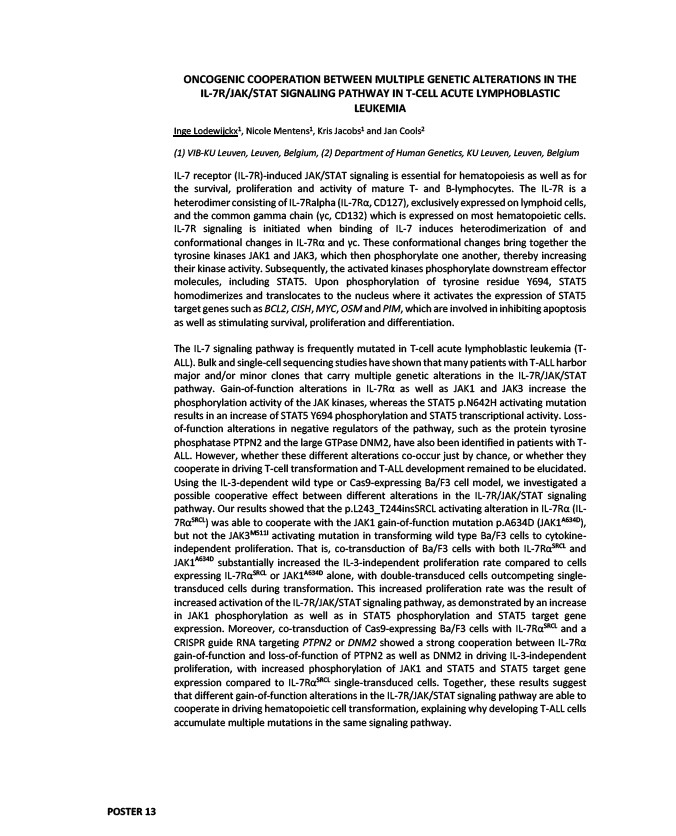
ONCOGENIC COOPERATION BETWEEN MULTIPLE GENETIC ALTERATIONS IN THE
IL-7R/JAK/STAT SIGNALING PATHWAY IN T-CELL ACUTE LYMPHOBLASTIC
LEUKEMIA
Inge Lodewijckx1, Nicole Mentens1, Kris Jacobs1 and Jan Cools2
(1) VIB-KU Leuven, Leuven, Belgium, (2) Department of Human Genetics, KU Leuven, Leuven, Belgium
IL-7 receptor (IL-7R)-induced JAK/STAT signaling is essential for hematopoiesis as well as for
the survival, proliferation and activity of mature T- and B-lymphocytes. The IL-7R is a
heterodimer consisting of IL-7Ralpha (IL-7Rα, CD127), exclusively expressed on lymphoid cells,
and the common gamma chain (γc, CD132) which is expressed on most hematopoietic cells.
IL-7R signaling is initiated when binding of IL-7 induces heterodimerization of and
conformational changes in IL-7Rα and γc. These conformational changes bring together the
tyrosine kinases JAK1 and JAK3, which then phosphorylate one another, thereby increasing
their kinase activity. Subsequently, the activated kinases phosphorylate downstream effector
molecules, including STAT5. Upon phosphorylation of tyrosine residue Y694, STAT5
homodimerizes and translocates to the nucleus where it activates the expression of STAT5
target genes such as BCL2, CISH, MYC, OSM and PIM, which are involved in inhibiting apoptosis
as well as stimulating survival, proliferation and differentiation.
The IL-7 signaling pathway is frequently mutated in T-cell acute lymphoblastic leukemia (T-ALL).
Bulk and single-cell sequencing studies have shown that many patients with T-ALL harbor
major and/or minor clones that carry multiple genetic alterations in the IL-7R/JAK/STAT
pathway. Gain-of-function alterations in IL-7Rα as well as JAK1 and JAK3 increase the
phosphorylation activity of the JAK kinases, whereas the STAT5 p.N642H activating mutation
results in an increase of STAT5 Y694 phosphorylation and STAT5 transcriptional activity. Loss-of-
function alterations in negative regulators of the pathway, such as the protein tyrosine
phosphatase PTPN2 and the large GTPase DNM2, have also been identified in patients with T-ALL.
However, whether these different alterations co-occur just by chance, or whether they
cooperate in driving T-cell transformation and T-ALL development remained to be elucidated.
Using the IL-3-dependent wild type or Cas9-expressing Ba/F3 cell model, we investigated a
possible cooperative effect between different alterations in the IL-7R/JAK/STAT signaling
pathway. Our results showed that the p.L243_T244insSRCL activating alteration in IL-7Rα (IL-
7RαSRCL) was able to cooperate with the JAK1 gain-of-function mutation p.A634D (JAK1A634D),
but not the JAK3M511I activating mutation in transforming wild type Ba/F3 cells to cytokine-independent
proliferation. That is, co-transduction of Ba/F3 cells with both IL-7RαSRCL and
JAK1A634D substantially increased the IL-3-independent proliferation rate compared to cells
expressing IL-7RαSRCL or JAK1A634D alone, with double-transduced cells outcompeting single-transduced
cells during transformation. This increased proliferation rate was the result of
increased activation of the IL-7R/JAK/STAT signaling pathway, as demonstrated by an increase
in JAK1 phosphorylation as well as in STAT5 phosphorylation and STAT5 target gene
expression. Moreover, co-transduction of Cas9-expressing Ba/F3 cells with IL-7RαSRCL and a
CRISPR guide RNA targeting PTPN2 or DNM2 showed a strong cooperation between IL-7Rα
gain-of-function and loss-of-function of PTPN2 as well as DNM2 in driving IL-3-independent
proliferation, with increased phosphorylation of JAK1 and STAT5 and STAT5 target gene
expression compared to IL-7RαSRCL single-transduced cells. Together, these results suggest
that different gain-of-function alterations in the IL-7R/JAK/STAT signaling pathway are able to
cooperate in driving hematopoietic cell transformation, explaining why developing T-ALL cells
accumulate multiple mutations in the same signaling pathway.
POSTER 13